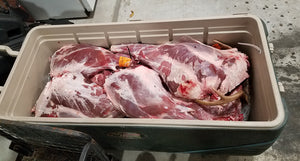Edible bits:
If you’re fortunate enough to fill a deer tag, then you know a thing or two in the realm of wild game processing. The first thing you know by now is that the work begins after the animal is down.
All the target practicing, studying of topo maps, scouting, preparation and countless hours spent in the field are just the precursor to what comes next. The real work involves field dressing the animal; getting it out of the woods either in whole or in portions; skinning; quartering; deboning; fileting every bit of tallow, silver skin, and gland from the meat; packaging the loin, backstraps, steaks, and roasts; and then two rounds (course and then fine) of grinding the trimmings into ground venison (e.g., Ven burg).
Side-bar: Why most people say venison tastes gamey isn’t a mental thing at all. Deer tallow, tendons, and endocrine glands in these wild animals all have a very strong and oft-times, off-putting flavor. This is why we highly recommend processing your own meat; removing tallow, connective bits, and glands takes time, time many if not most butchers can’t afford when they’re making $60 a deer to process the whole animal.
A 120-130lb animal (20% of the live weight is comprised of mostly stomach, intestines, and a bit of blood) will field dress down to about +/- 100lbs . If you’re prepared to harvest the internal organs (heart, lungs, liver, kidney) then you’re talking 45lbs of meat and 55lbs of hide, bone, brain, and other tissue: What can be consumed breaks down as follows:
45lbs of pure, lean, red meat:
- 6-8lbs of organ meat;
- +/- 20lbs of steak; and
- 18-20lbs of ground meat.
The second thing you know is respect for the animal. I’m not talking respect in a spiritual sense (although, if that’s what it means for you, cool. To each their own as my Grandma would say). By respect I’m referring to clean kills.
In terms of a clean kill there are a multitude of variables (weapon of choice, shooter confidence, distance to the game, velocity of the projectile, the speed of the animal, wind direction, etc) those details are best left for another, dedicated post on the topic. Suffice it to say that a broadside shot or a shot where the shoulders of the animal are slightly quartering/turned away are almost always going to be preferable. A well-placed shot near the top of the elbow, just behind the brisket is where the heart and lungs meet. This is where you want to aim. Lastly, visualize the angles through the animal and aim always considering where the exit hole will be. The exit is your true target.
It’s easy to be an arm-chair quarterback on the subject, but ultimately the only one who can decide whether the shot is worth taking is the individual in the situation being challenged by the decision. I myself have passed up plenty of opportunities on deer when it didn’t feel right. I’ve also taken good shots that have turned out bad due to any number of unintended and/or unforeseen factors (pulled the shot, didn’t notice a branch, a bow is more difficult to pull back in sub-freezing temperatures, etc).
On the flip-side I have taken marginal shots with confidence that have worked out beautifully (quartering to shot and the animal turns broadside when the arrow is released; a 46yrd shot that I had misjudged and had the 40yrd pin pegged on, and the animal crouches after hearing the arrow release and drops in only a few yards). Bottom line is the worse the shot, the longer the animal will be alive before it dies: And nobody likes tracking an animal over long distances; in the dark; in the rain; across a river.
And no one likes wounding an animal and not finding it. All that being said, anyone who has hunted long enough has probably lost an animal. I have, and whether it’s a trophy animal or not it’s never a good feeling. Scavengers do locate most of the game that is lost, but finding the animal is the next step in making sure we’re not being careless with this commodity.
As far as not being wasteful once you do locate your downed quarry; other than bone, fur, ligaments, and the deer’s primary nervous system (spinal cord, brain) and eyes, most of the animal is edible. If you haven’t eaten kidney, try it, it has a strong mineral taste, but really quite good.
One of the most underutilized and rather delicious parts of the animal is the tongue. If you’re not sure what to do with the front or hind shanks and front shoulders you can always filet all the meat and use it for grind or toss them whole into a pot-roast. Venison burger is very lean and has many uses.
Into the wild and HangryOutdoors,
Article written by Mike Hiller


